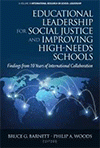
Educational Leadership for Social Justice and Improving High-Needs Schools
Findings from 10 Years of International Collaboration
Edited by:
Bruce G. Barnett, University of Texas at San Antonio
Philip A. Woods, University of Hertfordshire
A volume in the series: International Research on School Leadership. Editor(s): David Gurr, University of Melbourne, Australia. Elizabeth T. Murakami, University of North Texas.
Published 2021
To commemorate the 10-year anniversary of the International School Leadership Development Network (ISLDN), this book is a compilation of the work conducted by network scholars. This volume is the first comprehensive overview of the studies conducted by ISLDN members engaged in examining how social justice leaders and leaders of high-needs schools address the social conditions, learning experiences, and performance of their students. Other international school leadership research consortia have emerged in the 21st century; however, the ISLDN is the second longest operating project, after the International Successful School Principalship Project (ISSPP). Since its creation in 2010, ISLDN scholars have delivered papers at a variety of international conferences and shared findings in research publications, including books and special issues of journals.
Until now, ISLDN research findings have been disseminated separately for the project’s two strands: (a) social justice leadership and (b) leadership in underperforming high-needs schools. Therefore, the purpose of the book is to document the history and evolution of the ISLDN and to provide descriptions and reflections of the project’s research findings, methodologies, and collaborative processes across the two strands. This volume captures studies of school leaders from 19 countries representing six continents - Africa, Asia, Australia and Oceania, Europe, North America, and South America. The authors examine important external and internal contextual factors influencing schools in different cultural settings and provide insights about the values and practices of social justice leaders working in high-needs school settings. Numerous practical strategies are provided for school leaders working in schools with similar conditions. The concluding chapter by the co-editors synthesizes the structural factors, personal beliefs and values, and contextualized change management strategies that shape school leaders’ actions aimed at ensuring the best learning outcomes for their students.
Besides capturing the range of findings emerging from various ISLDN studies conducted over the past decade, several chapters critically examine the project’s current contributions to the field. Authors suggest broadening the dissemination of our findings to increase the visibility of the project, expanding the research methods beyond qualitative interviews, incorporating studies from non-Anglophone countries, and augmenting the scope of our analyses and research focus. These researchers’ journeys also reveal the obstacles to and benefits of engaging in these types of international collaborative research ventures.
CONTENTS
Acknowledgments. PART I: HISTORY AND REFLECTION OF THE ISLDN. Introduction, Bruce G. Barnett and Philip A. Woods. International Educational Leadership Projects, David Gurr, Lawrie Drysdale, and Helen Goode. Socially Just School Leadership: Ten Years of Learning From Each Other. Pamela S. Angelle and Michele Morrison. What Factors Help and Hinder the Work of Social Justice Leaders? A Summary of Findings From the Social Justice Leadership Strand, Deirdre Torrance, Ian Potter, Christine Forde, Pamela Angelle, Helene Ärlestig, Christopher Branson, Annie Cheng, Fiona King, Rachel McNae, Paul Miller, Michele Morrison, Katarina Norberg, Elson Szeto, and Joe Travers. The International School Leadership Development Network’s High-Needs Schools Strand: Ten Years of History, Jami Berry, Betty Alford, Mette L. Baran, Karen Bryant, Kristine Hipp, and Glady Van Harpen. Review of Methodological Approaches in Studies of High-Needs Schools Across Multinational Contexts, Nathern S. A. Okilwa. PART II: CROSS-STRAND AND CROSS-COUNTRY COMPARISON. From the Mouths of Babes: Policy Recommendations From P–12 Students, Keneisha Harrington, Britt-Inger Keisu, Björn Ahlström, Parker M. Andreoli, and Hans W. Klar. Leading Successfully in High-Needs Contexts: Australian and New Zealand Cases, David Gurr, Lawrie Drysdale, Fiona Longmuir, Kieran McCrohan, Rachel McNae, Michele Morrison, and Sylvia Robertson. A Comparison of Social Justice Leadership Meaning and Praxis: The Interplay of Unique Social Cultural Contexts in Turkish, Palestinian, and Lebanese High-Needs Schools, Khalid Arar, Deniz Örücü, and Julia Mahfouz. Economic, Cultural, Associational, and Critical Justice in Schools in Catalonia, Spain and Baja California, Mexico: A Pilot Study, Brian Corrales-Maytorena, Claudia Navarro-Corona, Charles Slater, Patricia Silva, Serafin Antúnez, and Michael E. Lopez. Social Justice Leadership in High-Need Contexts: Strategies From Principals in Spain, Mexico, and the United States, Cristina Moral, Elizabeth Murakami, and Celina Arcadia-Torres. Leadership for Sustained School Improvement in a High-Need School in Nepal and in Southern California: Vital Practices and Processes in Fostering Learning, Chetanath Gautam, Rosario Ambriz, and Betty Alford. Social Justice Imperatives for Leaders in High-Needs Schools: Research From ISLDN Studies and Issues for Future Consideration, Stephen Jacobson and Paul Miller. What Have We Learned About Social Justice Leadership in Struggling and Underserved Schools and Communities? Philip A. Woods and Bruce G. Barnett. About the Editors.
-
Paperback978-1-64802-372-9
Web price: $45.04 (Reg. 52.99)
-
Hardcover978-1-64802-373-6
Web price: $80.74 (Reg. 94.99)
- eBook978-1-64802-374-3

-
 Challenges and Opportunities of Educational Leadership Research and Practice
The State of the Field and Its Multiple Futures
Challenges and Opportunities of Educational Leadership Research and Practice
The State of the Field and Its Multiple Futures
-
 Educational Leadership, Culture, and Success in High-Need Schools
Educational Leadership, Culture, and Success in High-Need Schools
-
 Examining the Assistant Principalship
New Puzzles and Perennial Challenges for the 21st Century
Examining the Assistant Principalship
New Puzzles and Perennial Challenges for the 21st Century
-
 School and District Leadership in an Era of Accountability
School and District Leadership in an Era of Accountability
-
 School Principals in Mexico
Cases of Leadership Success
School Principals in Mexico
Cases of Leadership Success
-
 The Changing Nature of Instructional Leadership in the 21st Century
The Changing Nature of Instructional Leadership in the 21st Century
-
 Using Data in Schools to Inform Leadership and Decision Making
Using Data in Schools to Inform Leadership and Decision Making

